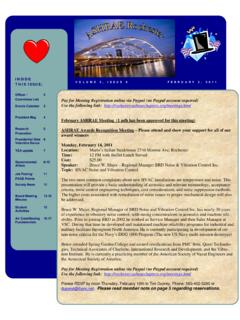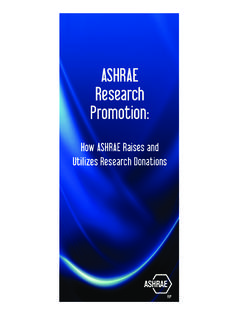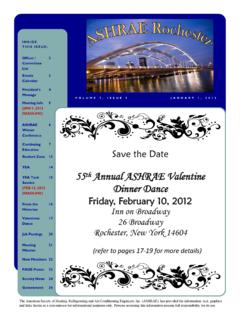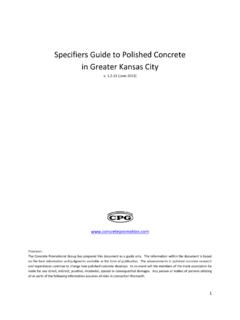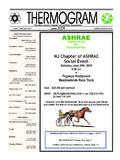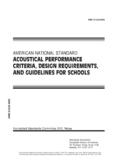Transcription of Chiller Plant Design - ASHRAE Region 7
1 Chiller Plant Design Julian R. de Bullet President deBullet Consulting 703-483-0179. ASHRAE WILL GIVE YOU. THE WORLD. This ASHRAE Distinguished Lecturer is brought to you by the Society Chapter Technology Transfer BECOME A FUTURE LEADER IN ASHRAE WRITE THE NEXT CHAPTER IN YOUR CAREER. ASHRAE Members who attend their monthly chapter meetings become leaders and bring information and technology back to their job. YOU ARE NEEDED FOR: Membership promotion research promotion Student Activities Chapter Technology Transfer Technical Committees Find your Place in ASHRAE ! Visit Complete the Distinguished Lecturer Event Summary Critique CTTC needs your feedback to continue to improve the DL Program Distribute the DL Evaluation Form to all attendees Collect at the end of the meeting Compile the attendee rating on the Event Summary Critique Send the completed Event Summary Critique to your CTTC RVC and ASHRAE Headquarters Forms are available at: What is a Chiller Plant ?
2 Major components: Building or Process cooling load Water cooled Chiller - (this can be air-cooled). Cooling Tower Pumps and piping Controls Why use chilled water? Chilled Water Is A Great Way To Move Energy Around A Building A 2 Pipe Moves As Much Energy As A 42 Duct A Chilled Water Coil W/ Valve Can Offer Excellent Control Dehumidification Chiller plants Can Be Very Efficient Locate Equipment Away From Occupants Service Sound Safety Energy Usage Energy Use by Sector Electricity Use by Sector Transportation 29% Residential Other 22% 28%. Buildings Industry Commercial 19%. 72%. 30%. Source: Energy Information Administration 2009.
3 Talking about Green? Sustainability? and High Performance! Green: More efficient equipment Sustainable: Design considers the big picture, how is equipment made, where it is installed, how long it lasts . High Performance: High Efficient equipment, sized, installed and maintained correctly for maximum impact Conventional Cooling Profile 1600. 1400. 1200 Cooling 1000. k avg. electric load Pumps 800. Fans W. 600. 400 Lighting 200. Base Load 0 6 AM 12 PM 6 PM. Full load on Design Day . Chiller 58%. Fans 24% Tower Pumps 5%. 13%. Design Performance Question: What is a cooling Design Day . a. The day the building load calculation was begun?
4 B. The first day the HVAC System is turned on? c. The hottest day of the year? d. The coldest day of the year? Question: What is a cooling Design Day . a. The day the building load calculation was begun? b. The first day the HVAC System is turned on? c. The hottest day of the year? d. The coldest day of the year? ANSWER: c Basic system Chiller Cooling Tower Building Cooling Load Pumps and Piping Annual Energy Usage Chiller Fans 33%. 43%. Tower 2%. Pumps 22%. Annual Energy Usage Chiller Basics Air, Water Or Evaporatively Cooled Reciprocating, Scroll, Screw Or Centrifugal Compressors DX or Flooded Evaporators Single Chiller Cooling Cooling Air Handling Unit Tower Tower Water-Cooled Chiller Condenser Chilled Water Pump Water Pump Section 7 System Piping Arrangements Typical Air-Cooled Chiller Piping Detail Air-Cooled Chiller Pressure Gauge (Typical).
5 Return Supply Thermometer Drain Valve (Typical). Shutoff Valve (Typical). Section 6 Typical Piping Details at Equipment Typical Water-Cooled Chiller Piping Detail Supply Return Supply Return Shutoff Valves Chilled Thermometer (Typical) Water Water-Cooled Chiller Condenser Water Drain Drain Flange (Typical) Valve Valve Pressure Gauge (Typical). Strainer (if pump is on return side of Chiller ). Section 6 Typical Piping Details at Equipment Typical Cooling Towers Cooling towers are heat rejecters. They do not condense refrigerant so they are not considered condensers. Section 4 Cooling Towers Basic Cooling Tower Operating Characteristics Approximately 90 F.
6 Saturated Air 95 F. 95 F db From Water-Cooled 78 F wb Condenser 85 F. Back to Condenser Cooling Tower Section 4 Cooling Towers Closed-Loop System Chiller Piping 45 F. Coil Expansion Tank Two-Way Valve Pump 55 F Three-Way Valve Includes: A Chiller and/or a boiler Coils that produce cooling or heating Two or three-way valves to control the coils Piping and pump to circulate water An expansion tank (insignificant water contact with air). Section 2 Types of Piping Systems Open-Loop System Water-Cooled Condenser 94 to 95 F. Chiller 3 gpm/ton Condenser Water Pump 85 F. Cooling Tower The water-cooled condenser is typically part of a water-cooled Chiller or water-cooled package unit A cooling tower rejects the condenser heat to the atmosphere Flow rates and temperatures are industry standards for North America Piping and pumps circulate water Water is reused and exposed to the ambient conditions in the cooling tower Section 2 Types of Piping Systems Once-Thru Water System Once-Thru Chiller with Optional Condenser Valve Source of Water to Piping waste or water (river).
7 Source Pump Much less common due to environmental concerns Water is sent to waste or returned back to source Large consumption of water Source example: river, lake, well Section 2 Types of Piping Systems Question: What is a Closed Loop? a. The pipe is capped b. It is not open to the atmosphere c. The chilled water piping is a closed loop Question: What is a Closed Loop a. The pipe is capped b. It is not open to the atmosphere c. The chilled water piping is a closed loop ANSWER: b and c Closed loop and Open loop- Recap! Closed Loop The chilled water piping is usually a closed loop A closed loop is not open to the atmosphere The pump needs only to overcome the friction loss in the piping and the components The pump does not need to lift the water to the top of the loop Open Loop When open cooling towers are used in the condenser piping The condenser pump must overcome the friction of the system and lift.
8 The water from the sump to the top of the tower Flow and Capacity Q = W x Cp x deltaT. Where Q = Quantity Of Heat Exchanged (Btu/hr). W = Flow Rate Of Fluid (US gpm). Cp = Specific Heat Of Fluid deltaT = Temperature Change Of Fluid ( F). For Water Q (Tons) = US gpm x ( Fin - Fout) x 500. Q (Btu/hr) = US gpm x ( Fin - Fout)/24. Load Basics Chilled Water Coils Transfer Heat From Building Air To Chilled Water Process Loads Cooling Jackets 1-Pipe Distribution System Monoflow . Fitting Typical Heating Terminal Boiler Typical Heating-Only Main Piping Loop Supply and Return System (1 size throughout). System Pump Section 3 Water Distribution Systems 2-Pipe Distribution System Summer Mode Typical Heating and Cooling Terminal Supply Piping Boiler Return Piping System Pump Chiller Section 3 Water Distribution Systems 3-Pipe Distribution System Distributes hot and cold water simultaneously Typical Heating and Cooling Terminal Chilled Water Supply Hot Water Supply Boiler Special 3-pipe Water Control Common Return Piping with Mixed Hot and Cold Water System Chiller Pumps Section 3 Water Distribution Systems 4-Pipe Distribution System Distributes hot and cold water simultaneously 4-Pipe Heating and Cooling Terminal
9 Chilled Water Supply Hot Water Supply Boiler System Chiller Pumps Section 3 Water Distribution Systems Direct and Reverse Return Systems Reverse Return Horizontal Distribution Unit-1 Unit-2 Unit-3 Unit-4 Unit-5. Supply Return Return header flow is same direction as supply flow Water leaves Unit-1 and goes all the way around in returning to source The first unit supplied is the last returned Circuit pressure drop through Unit-1 = Unit-2 = Unit-3 = Unit-4 = Unit-5. Balancing valves may be eliminated Section 4 Direct and Reverse Return Systems Direct Return Horizontal Distribution Unit-1 Unit-2 Unit-3 Unit-4 Unit-5. Supply Return Balancing Valves Water enters Unit-1 from supply Water leaves Unit-1 and returns directly to source The first unit supplied is the first returned Unequal circuit pressure drops result Circuit pressure drop through Unit-1 < Unit-2 < Unit-3 < Unit-4 < Unit-5.
10 Balancing valves are a necessity Section 4 Direct and Reverse Return Systems Piping Materials Typical Materials: > 2 - in. Schedule 40 black steel < 2 - in. Schedule 40 black steel or Type L copper Section 5 Water Piping Components and Accessories Control Valves Valve Actuator 3-Way Diverting 3-Way Mixing 2 outlets 1 inlet 2 inlets 1 outlet 2-Way Modulating Section 5 Water Piping Components and Accessories Expansion Tanks Open to Compressed atmosphere Air Space Diaphragm Air Overflow Drain Open Tank Closed Tank Closed Diaphragm Tank Open to air Very popular Flexible membrane Air-water interface Captured air space No air-water interface Air-water interface Very popular Section 5 Water Piping Components and Accessories Piping Example Piping Example Given The Following
